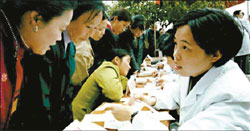Women's cancer fight gets crucial boost
Doctors from a hospital in Gaoba Prefecture in Yidu of Hubei Province give volunteer medical consultations to village women. Cao Lida |
Laid-off in 1994 from a local textile factory, 44-year-old Li Lanyun said that the annual physical check-ups she had when still employed did not include screening for cervical or breast cancer.
"So for all these years, I don't know whether I was even healthy, let alone aware of cancer prevention," she said.
In a bid to raise awareness of the two cancer threats, the China Cancer Foundation has launched a nationwide campaign. Introduced on International Women's Day, women are encouraged to take part in breast and cervical cancer examinations for the early detection and treatment of the diseases.
As part of the initiative, Li was undergoing her first ever screening for cervical cancer free of charge at the General Hospital of Tianjin Medical University, along with 140 other low-income and unemployed women.
"I've learnt that cervical cancer is preventable, as long as you avoid risk factors like having a high number of sexual partners."
With a mini-loan from the local government, Li started a domestic service company with female staff of 600 workers. She said that she has shared her new knowledge of cancer risks with her employees.
"It's a ripple effect," said Zhou Qinghua, president of the General Hospital of Tianjin Medical University. "You educate one woman with the knowledge, and she might influence someone else."
Zhou said that this "ripple effect" is important because it is impossible for medics to reach all of the women that are in need.
"HPV (Human Papilloma Virus) is the primary cause of cervical cancer found in almost all patients with the condition, and spread through sex," said Qiao Youlin, a noted Chinese cancer epidemiologist.
Qiao added that cervical cancer is the second most menacing killer, after breast cancer, affecting about 140,000 Chinese women each year, or about 20 per cent of the worldwide total.
So far, more than 3,000 women in 30 cities like Li Lanyun have had free screenings for breast and cervical cancer.
Some public interest groups, including the American Chamber of Commerce in China who donated 200,000 yuan ($25,000), have joined the campaign. The Beijing-based International Healthcare Promotion Society of China also assisted in setting up a program to help low-wage earners, such as migrant workers in the capital and rural women in the suburbs.
At the Capital University of Medical Sciences in Beijing, experts on breast cancer have been teaching a group of low-income women how to examine themselves, which still remains an embarrassing topic in 21st century China.
Chen Xiaoling, a pathologist from the Capital University who is in charge of the program said, "This group of women are struggling for survival, averaging 280 yuan ($35) a month a regular medical check-up is impossible for them."
Chen added that, early detection of breast cancer slashes the mortality by 30 per cent.
"Unfortunately, the vast majority of women don't know how to do it," she said, "and those who know how haven't developed the habit of practicing it."
Chen also noted how cases of breast cancer are taking off in China, hitting younger and younger women.
"Due to changes in lifestyle, the threat of cancer looms ever larger in China," she said.
The self-help course enables women and medical workers to identify key risk factors menstruation starting in girls under the age of 12, menopause later than 50, contraceptive pills taken without doctor's advice, and the absence of breastfeeding.
"It's the medical community's social responsibility to prepare women with health knowledge," said Qiao, "only when their health improves can we expect the whole population's health to improve."
(China Daily 03/14/2007 page19)















